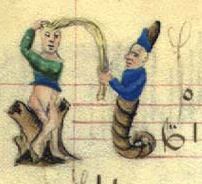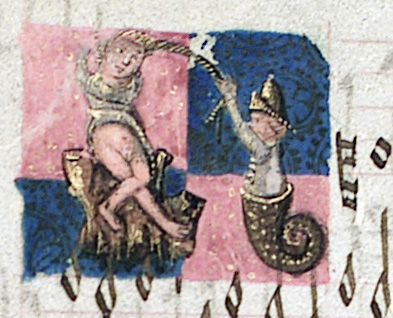Wolfenbüttel
Wolfenbüttel, Herzog August Bibliothek, MS Guelf. 287 Extrav.
Facsimile – at http://diglib.hab.de/wdb.php?dir=mss/287-extrav.
Modern editions – Gutiérrez-Denhoff 1988; online edition by Clemens Goldberg (2011) at the Goldberg Stiftung.
Scholarly literature (selection) – Jeppesen 1927; Gutiérrez-Denhoff 1985; Higgins 1987; Alden 1999; Fallows 1999b; Alden 2010 - especially the very detailed description in Appendix A (A5- PDF).
Description
Small parchment chansonnier, c. 15 x 10,5 cm, 70 folios (of original 80), modern binding of white leather, 10 fascicles: modern foliation starting at the first surviving folio (one folio between ff. 6 and 7 was erroneously left out (f. 6bis)); pages ruled in red ink, music and texts in brown/black ink; decorated initials. Part of fasc. 9 (ff. 66v ff) and all of fasc. 10 most probably from the start contained blank, ruled pages only – as extra space for musical additions.
The original contents probably were 53 chansons and one introductory motet, all copied without any composer ascriptions by the main scribe (the Wolfenbüttel scribe) and supplemented by the second scribe (WolfenbüttelB). All of the original repertory is still present; the loss of two folios (before f. 1 and between ff. 63v and 64), however, has made two songs incomplete. Fascicle 9 contains later additions (hands WolfenbüttelC-D).
Fascicle structure (see also the extended List of contents) – ten fascicles (gatherings), originally all of four bifolios (quaternions):
Fasc. 1, ff. 1-6bisv – the removal of the fascicle’s 1st and part of the 2nd folio has made the first piece incomplete.
Fasc. 2, ff. 7-14v.
Fasc. 3, ff. 15-22v.
Fasc. 4, ff. 23-30v.
Fasc. 5, ff. 31-38v.
Fasc. 6, ff. 39-46v.
Fasc. 7, ff. 47-54v.
Fasc. 8, ff. 55-62v.
Fasc.9, ff. 63-67v – one bifolio and the last folio have been removed, which creates lacunae between ff. 63 and 64 (1 folio missing) and after f. 67. Hereby two pieces were made incomplete, one of them, »Entre Peronne et Saint Quentin«, f. 67, were added by the younger scribe, WolfenbüttelD. The opening including the verso of the missing folio 63a probably did not have music, as the recto f. 64 contains painted initials for tenor and contratenor parts only, but no music.
Fasc.10, ff. 68-69v – only two single leaves remain, both blank but ruled with staves, later pen trials. All of fascicle 10 probably contained blank, ruled pages.
Decoration
All pages copied by the Wolfenbüttel scribe plus two further openings have decorated initials. The initials are formed by grotesque figures, which all were designed with the help of the same pattern book.
The Copenhagen chansonnier was decorated with similar initials in the same workshop, or in a workshop using the same or a similar pattern book. See for example the letter “N” used in both sources at the beginning of »N’aray je jamais mieulx que j'ay« by Robert Morton (see Figure 1, other letters using similar patterns are, “A”, “J”, or “L”, and “T” found on Copenhagen ff. 10v, 22v, 16v, and 34 – and Wolfenbüttel ff. 16v, 5v, 55v, and 2 respectively); the initial in Wolfenbüttel is the only one using a coloured background, all the rest are freestanding. It is also the only one showing a person with a naked lower part of the body; there are plenty of nudes, but only one with a covered upper body. This type was, however, popular with the decorator of the Copenhagen chansonnier, cf. ff. 5v, 6v, and 35v.
 |
 |
Figure 1, Copenhagen f. 2v and Wolfenbüttel f. 6bisv
Genesis
Following the opening motet, the name of the first owner or dedicatee is revealed in an acrostic formed by the initials of the next 12 songs “ESTIENE PETIT”. Étienne Petit was probably the second of this name (1448-1514). He was based in Paris and served as a royal notary and secretary since 1467. During his nearly fifty years in royal service he obtained influential positions, many honours and great wealth. He was young when the chansonnier bearing his name was ordered, of the same age as the youngest composers represented in the MS (Basiron for example). The chansonnier would be a suitable gift for an ambitious youngster attuned to the culture of courtly circles during the years before his marriage (see Alden 2010, pp. 188 ff).
The main writer completed his work on the chansonnier after a relatively short period of time, it probably did not stretch over much more than a couple of months including time for finding the repertory to form the acrostic. Then the sheets were sent to a painter's workshop for decoration. It was apparently planned that two further openings, consisting of the now lost f. 63av and f. 64 and ff. 64v-65, should have music, and decorated initials were therefor painted on these pages also. Returned to the music scribe's workshop a second writer entered the song »Jamais si bien ne me puelt advenir«, which matched the painted initials on ff. 64v-65, but he seems to have been unable to find an appropriate song for the first painted opening, and in stead he copied the song »Ma dame trop vous m’esprenes« on the next, unpainted opening. The painted pages, ff. 63av-64, were left without music.
The two last pieces in the chansonnier were entered by the hands C and D a short time later, probably before the end of the 1470s.
Except for the acrostic formed by the opening songs the Wolfenbüttel chansonnier does not contain many traces of its original and later owners. Among pen trials in fasc. 10 is possibly the name of a later owner, “Phylippe St Simon” (f. 69).
Dating and relative dating
1470-1471, based on the appearance of the chansons by Philippe Basiron, cf. my article ‘The chansons of Basiron’s youth and the dating of the ‘Loire Valley’ chansonniers’. The preliminary analysis of the repertories of the Wolfenbüttel and Laborde chansonniers on this site furthermore shows that the Wolfenbüttel scribe and the original Laborde scribe were contemporaries, working in the same area and often used similar or identical exemplars for their copying.
This dating reverses the sequence of events sketched in Alden 2010, pp. 125-126. I find that the Nivelle and Dijon chansonniers probably are the earliest, begun during the last years of the 1460s, while Laborde and Wolfenbüttel enter the picture a short time later.
Datings in the musicological literature: Jeppesen 1927, 1480-1490; Perkins 1979, late 1470s or early 1480s; Gutiérrez-Denhoff 1985, c. 1460-1470; Alden 2010, main layer c. 1465-1470s, hands B-D 1480s.